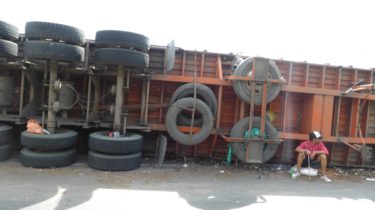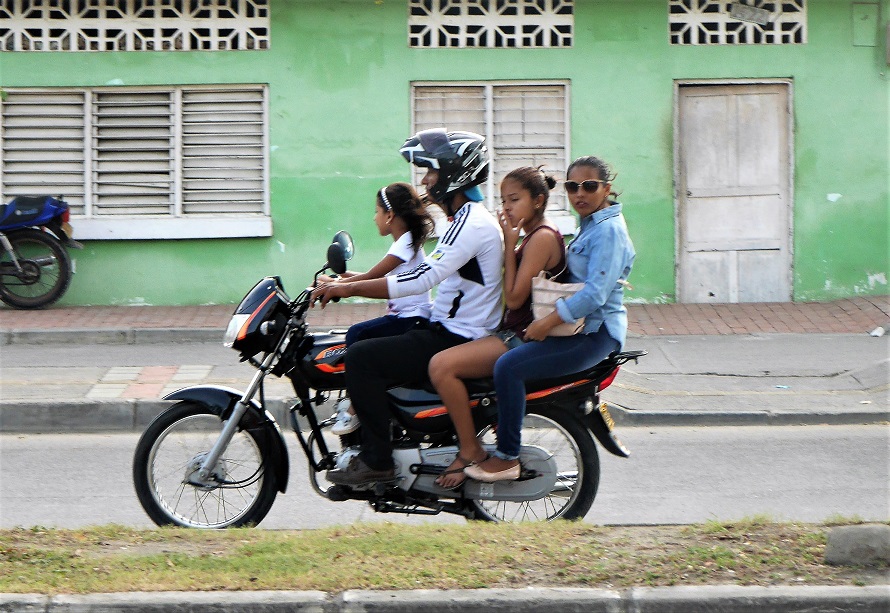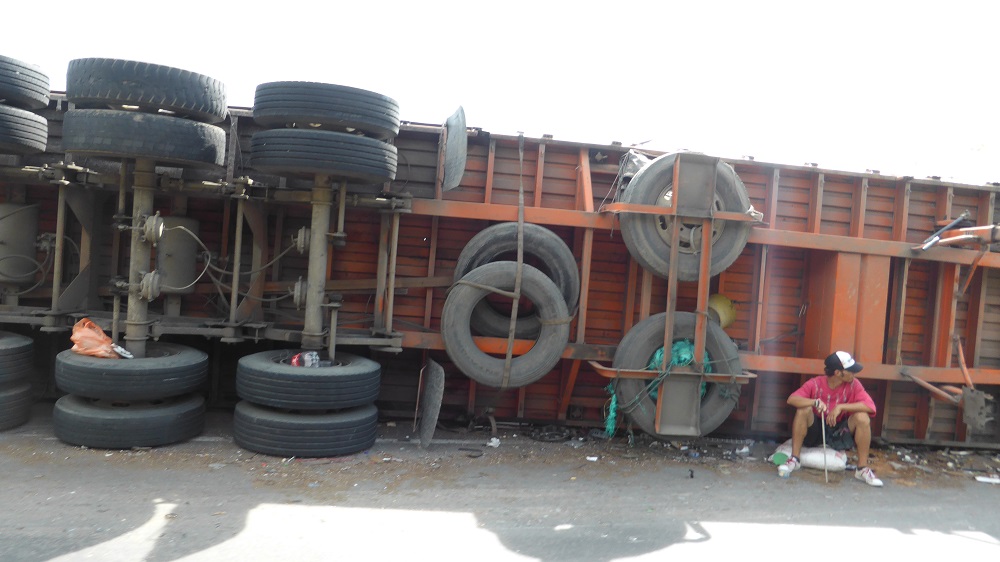Time for Colombia to belt up

Road accidents are the country’s biggest killer.
by Steve Hide
This article first appeared in The City Paper, in 2016
I am trying to give away an infant’s car seat to a friend, a mother of a two-year-old, but she is having none of it: ‘I don´t think we’ll use it. I mean, she will probably cry if we strap her in. She is used to being free in the car.’
‘But she will get used to it after a few days. All kids do,’ I say, to no avail. No car seat for Chiquita. She will grow up like many Colombians, desensitised to road safety from an early age.
This is ironic because in other ways her life is wrapped in cotton wool. If Chiquita has even the slightest sniffle her parents rush her to the hospital for extensive tests. And ironically, Chiquita´s mum was herself maimed in a vehicle crash in her youth. And doubly ironic is that Chiquita’s mum is a professional adviser in work-place risk reduction. The point is she just does not see the danger of a small kid loose in a big car. And if she doesn’t get it, who will? (Sorry to pick on you, Mrs Chiqui , but the car seat is still here if you change your mind).
This lack of vision explains why the country registers around 6,000 road deaths a year – that’s one every 90 minutes – and 40,000 serious injuries. Traffic accidents are the largest cause of mortality in young people, and have killed more Colombians than violence in 50 years of conflict.
The figures are alarming, though if you spend time in Colombia you do not need statistics to spell out the dangers. Out on the streets I started to keep a mental log of accidents encountered. In Bogota over a month on every journey I saw a recent crash (usually a motorbike) and several times I witnessed the actual moment of impact.

Once was very close to home, 20 metres from my flat, when I heard a screech of tyres and sound of crushed metal, and a motorbike helmet landed empty at my feet. I looked up to see the rider lying still and unresponsive on the road, her distraught passenger (whose helmet had stayed on) crouched over her repeating ‘Mum, how many time have I told you to do up the strap on your helmet.’
But at least they had helmets, even if half undone. Visiting the coast last week where motos reign supreme I was astounded how things are going backwards regarding safety. Ten years ago when I lived there, police would at least make a token effort to enforce helmet-wearing and control the pillion passengers. But not anymore. In Monteria, a bustling city where moto taxis are the main form of public transport, I saw whole families of five, all helmet-less, crammed on motorbikes weaving crazily through the traffic, and police standing just steps away glued to their smartphones.
Not surprisingly, motorbikers make up 60% of all accident victims and by far the most deaths. In 2014, a staggering 2,900 people were killed on – or rather, falling off – motorbikes compared to 290 dead in cars crashes and 340 knocked off bicycles. But in the same year 1,750 pedestrians were killed by vehicles, of which an increasing number are over 70 years old.
I suspect that many older people killed on foot are hit by the same motorbikers that would be otherwise killing themselves. I base this on the fact that every time my mother-in-law calls us she tells of another elderly neighbour who was that very week knocked down and killed by a moto. And the fact that the sheer numbers of motorbikes makes navigating public spaces a live game of Space Invaders. Plus that increasingly motorbike riders, perhaps inspired by the old adage ´keep death off the roads, drive on the pavement’, are doing just that.
I first saw this phenomenon in towns on the Pacific Coast where bikers fed up with traffic queues would roar down the pavement scattering pedestrians. Then last week I saw it for the first time on the Caribbean coast, mostly as a result of new road designs that create long lanes divided by concrete barriers. The riders cannot be bothered to drive along and find a retorno so instead just cruise down the pavement against the traffic flow to save time. The police, of course, do nothing, and I got so angry trying to shepherd various small children along these dangerous footpaths I was ready to find an iron bar and whack it in the spokes of the next moto transgressor.

Of course I am not the only person in Colombia to feel this. The Ministry of Health has long recognised traffic as a major health risk and compiles an annual ‘epidemiological’ analysis, the last one (2015) giving some handy insights on what to avoid, mainly not being a motorbike rider aged 20 to 24.
Unfortunately these figures only show the gross number of accidents and not the number of mishaps ‘per journeys made’. But we can maybe assume that there are more motorbike journeys than a car trips (there are about 6 million motorbike registered in Colombia and 4 million cars and pick-ups). Common sense dictates that you are more vulnerable on a motorbike than in a car. And the sheer number of people on foot and their vulnerability to hard objects contributes to the high pedestrian toll.
According to insurance data, two thirds of road deaths are caused by ´multiple injuries’ and a third specifically by skull or thorax trauma. The accidents are caused mainly by speeding, ignoring road signs and traffic lights, and the road conditions themselves (swerving to avoid puddles and potholes) also play a large part. The same source suggests ‘distractions’ are a common trigger for accidents, and rather unfairly states the first one as ‘putting on makeup’ (I say ‘unfairly’ because men are four times more likely to crash than women).
Of course fiddling with your smartphone is high on the list of distractions, and I was amazed to see a recent new trend among Bogota taxi drivers to watch TV novelas on dashboard-mounted tablets, as if they did not have enough on their plate just talking and texting by phone while driving around Bogota.
And the weekend traffic can be a killer with 21% of road deaths on Saturdays or Sundays compared to 13% on an average weekday. This might be from factors such drunk driving, low staff levels in hospitals (or both). As expected, in actual numbers the most road deaths are in urban areas with Cali, Medellin and Bogota leading the way. But in terms of deaths per number of people living in an area, an unexpected pattern emerges. By this measure the Llanos departments of Casanare, Arauca and Meta have the most dangerous roads, along with Cesar and Huila. This is down to large numbers of motos in the towns, but also I suspect is because they have long stretches of fast straight road where people hurtle along and any mistake will be devastating. In contrast, in Bogota the number of fatal accidents per population is below average, partly because more people take public transport but also because traffic rarely reaches very high speed.
One root cause is that people do not actually learn to drive, as I discovered when I went to get my Colombian driving licence. The driving school had no intention of providing lessons but instead asked me to sign fabricated ‘class attendance’ records which would then presented to the transit authorities. ‘But I want a lesson,’ I told the person at the school. ‘Don´t be silly, you already know how to drive,’ he told me, on the basis that I had gone once around the block. I checked with friends and colleagues. Not one had actually done lessons to get their licence. Even the national police chief admitted last year that ‘not a single person in Colombia has ever failed their driving test’.

Driving schools could at least promote safe driving and explain the benefit of seatbelts, which in countries where enforced reduce serious crash injuries and deaths by an estimated 50%. Infant seats reduce the risk to babies by 70%. But in Colombia infant car seats are rarely used. Seat belts often are fitted but from my observations people find every opportunity not to use them. Traveling with my Colombian in-laws, they click on their seatbelts at an approaching police check, but unclick them as soon as the ‘danger’ has passed.
So what to do. The Colombian government, perhaps feeling the heat from global entities such as the UN, World Bank and WHO, last year declared traffic accidents a public health emergency and set up a National Road Safety Agency tasked with reducing road accidents by 25% over 5 years.
Some change is on its way. Drink driving campaigns are bearing fruit. Speed and radar camera traps are showing results in selected zones (but usually on new roads already safer to drive). New laws are being passed that mean new cars in Colombia have to be fitted with airbags, headrests (to reduce whiplash injuries) and anti-lock braking. But will this be enforced? Take the recent confusion over rear seat belts, which have been obligatory to be fitted in cars since 2004, but it was never clear if the law required them to be used. In fact the Ministry of Transport went out if its way in early 2015 to assure Colombians that they ´would not be imposing fines´ for failure to use backseat belts… Then later in the year announced, no, you do need to use them. Talk about mixed messages. There was a few-week flurry where taxi drivers suggested we put seatbelts on in the back, but that soon fizzled out and the belts disappeared back behind the seat cushions.
And what about motorbikes? One reason for the rise in motos circulating in Colombia– from one million to six million in 15 years – is lack of public transport with in many areas the motos themselves filling the gap. In rural areas mototaxismo is an essential service to reach remote villages. But in large crowded cities it is illegal so exists unchecked (and largely unregulated) often backed criminal groups leaving authorities powerless to stop it. Cities like Cali count on an estimated 4,000 illegal mototaxis. Nationwide an estimated 10% of all public transport trips are done on the back of motorbike. It is slowly spreading to Bogota, and Uber wants in.
Not everyone is against it; proponents argue mototaxismo is cheap and door-to-door, fills the public transport gap, and economically supports large numbers of people otherwise out of work. Thus it is a social as well as transport issue. In Pasto, for example, an estimated 6,500 people derive their livelihoods from illegal transport. But it is also the reason many public buses systems in cities like Monteria fail, everyone just jumps on a rapi, which is half the price of the bus. And there is also the long-term social impact of road accidents with 150,000 Colombians currently crippled for life by vehicle injuries, and an estimated annual health cost of $ 23,000 million for survivors of motorbike crashes.
Of course in a perfect world we all drive carefully, stop watching dashboard TV, put on seatbelts, wear crash helmets, or sell the moto and take the bus because we want to stay safe. Behind that is education and habits, as much as laws and enforcement (though it would help if the police pull their finger out and stop driving their own motorbikes through red lights).
And deep down the issue is how we personally measure risk. My Colombian friends are often amazed when I take some rural backroad through a supposed conflict zone and emerge alive. I am constantly moaning at their lack of seatbelts, failure to use child seats and habit of cramming twelve relatives and a dog in the rear seat. Not to mention the non-stop Vallenato music
But if official figures show that crashes kill more people than the conflict then it is time for change. Come on Colombia, belt up.
